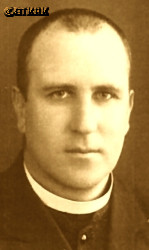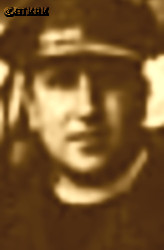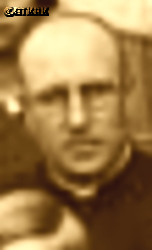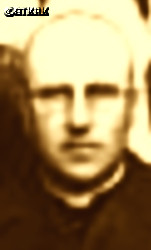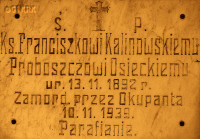Roman Catholic
St Sigismund parish
05-507 Słomczyn
85 Wiślana Str.
Konstancin deanery
Warsaw archdiocese, Poland
full list:
displayClick to display full list

searchClick to search full list by categories
wyświetlKliknij by wyświetlić pełną listę po polsku

szukajKliknij by przeszukać listę wg kategorii po polsku

Martyrology of the clergy — Poland
XX century (1914 – 1989)
personal data
surname
KALINOWSKI
forename(s)
Francis (pl. Franciszek)
function
diocesan priest
creed
Latin (Roman Catholic) Church RCmore on
en.wikipedia.org
[access: 2014.09.21]
diocese / province
Culm (Chełmno) diocesemore on
pl.wikipedia.org
[access: 2012.11.23]
RC Military Ordinariate of Polandmore on
en.wikipedia.org
[access: 2014.12.20]
honorary titles
Silver „Cross of Merit”more on
en.wikipedia.org
[access: 2019.04.16]
(22.12.1927)
„Medal of Independence”more on
en.wikipedia.org
[access: 2019.02.02]
„Iron Cross” i.e. Germ. „Eisernes Kreuz” (German Empire)more on
en.wikipedia.org
[access: 2020.04.25]
date and place
of death
10.11.1939

Zajączek foresttoday: Skórcz gm., Starogard Gdański pov., Pomerania voiv., Poland
more on
en.wikipedia.org
[access: 2022.01.28]
details of death
From 1913 soldier of the German Imperial Army — in the infantry.
During World War I awarded the Iron Cross for the bravery on the western frontline. Taken POW by the French.
Released after end of World War I hostilies volunteered in 1918 to Gen. Haller's Polish Army in France („Blue Army”). With this army returned to the–then independent Poland in 1919.
The units of General Haller's Army took part, among others, in the Polish–Ukrainian war 1918‐1919 in Eastern Galicia and Volyn, forming the base of the Galician Front. Then they were sent to the front of Polish–Russian battles — the Polish–Russian War of 1919‐1921 was beginning. Others, even before the signing of the Treaty of Versailles ending World War I on 28.06.1919, were sent to the formally still Germ. Provinz Posen (Eng. Poznań Province), i.e. Greater Poland, forming the main forces of the Polish South‐Western and Southern Fronts, protecting Greater Poland from German attacks.
After the entry into force of the treaty on 10.01.1920, the units of the Polish Pomeranian Front under the command of Gen. Joseph Haller — including former units of the „Blue Army” — entered Pomerania, granted to Poland by the treaty. Was a soldier in one of these units.
Then prob. took part in the Battle of Warsaw on c. 1920 (known as the „Miracle on the Vistula”), when the Poles defeated the Russian offensive, ensuring the independent existence of the Polish state.
Demobilised in 1921.
By order of the President of the Republic of Poland of 24.10.1931, with seniority from 01.09.1931 and 10th place among chaplains of the Roman Catholic military clergy, appointed reserve chaplain of the Polish Army (for a statutory 2‐year period).
After German invasion of Poland on 01.09.1939 (Russians invaded Poland 17 days later) and start of the World War II, Osiek was captured by the Germ. Wehrmacht (Eng. Armed Forces) troops on c. 03.09.1939.
After start of German occupation, dragged out on 02.10.1939 by the Germans from his rectory.
Slashed with bayonets, tortured.
Jailed in a IL Skurz transit camp in Skórcz.
Murdered in the Zajączek forest, c. 4 km from Skórcz, near Lake Głuche, prob. in a mass murder — part of the Germ. «Intelligenzaktion» (Eng. Intelligence Action) plan to exterminate the Polish intelligentsia and leadership — in which Fr Marian Felchnerowski and Fr Bolesłav Łożyński were also murdered (Fr John Rogalski was murdered by the Germans a few weeks later), as well as several prominent Polish activists from Skórcz and the surrounding area.
The arrests and murders were carried out by members of the genocidal German organization Germ. Volksdeutscher Selbstschutz (Eng. Ethnic German Self‐Defense), i.e. representatives of the German minority in Poland, supported by the Germ. Landesgendarmerie (Eng. State Gendarmerie), subordinate to the Germ. Ordnungspolizei (Eng. Order Police), i.e. OrPo, in Gdańsk, a formation directly subordinated to the genocide mastermind Heinrich Himmler, as the Germ. Chef der Deutschen Polizei (Eng. Chief of the German Police).
The victims were transported or brought to the execution site — from the IL Skurz internment camp in Skórcz — under armed escort. There, were ordered to enter prepared pits, after which they were shot at close range. At times they were simply ordered to stand over the edge of the pit. Then, the executioners, often under the influence of alcohol, shot their victims in the back of the head. After the executions were completed, the pits were buried.
Altogether in the Zajączek forest, the Germans, from 10.1939 till 12.1939, as part of the German Germ. «Intelligenzaktion» murdered c. 100‐150 inhabitants of Skórcz and the surrounding area (according to some sources 143), and the bodies were buried in 6 mass graves.
Among the victims were 12 mentally retarded people, chronically mentally and neurologically ill, living in the „Poor House” in Skórcz. Their murder was part of the German genocidal plan Germ. „Vernichtung von lebensunwertem Leben” (Eng. „elimination of life unworthy of life”), covered by the so‐called «Aktion T4».
alt. details of death
According to some sources arrested on 10.11.1939 and murdered on the same day.
cause of death
mass murder
perpetrators
Germans
sites and events
«Aktion T4»Click to display the description, IL SkurzClick to display the description, «Intelligenzaktion»Click to display the description, Reichsgau Danzig‐WestpreußenClick to display the description, Ribbentrop‐MolotovClick to display the description, Pius XI's encyclicalsClick to display the description
date and place
of birth
13.11.1892Birth certification on:
www.genealogiawarchiwach.pl
[access: 2025.09.08]

Szwarcenowotoday: Biskupiec gm., Nowe Miasto Lubawskie pov., Warmia‐Masuria voiv., Poland
more on
en.wikipedia.org
[access: 2021.09.02]
parents
KALINOWSKI Theodore
🞲 ?, ? — 🕆 ?, ?

NEUMANN Monica
🞲 ?, ? — 🕆 ?, ?
presbyter (holy orders)
ordination
28.06.1925

Pelplintoday: Pelplin gm., Tczew pov., Pomerania voiv., Poland
more on
en.wikipedia.org
[access: 2021.05.06]
Assumption of the Blessed Virgin Mary RC cathedral churchmore on
en.wikipedia.org
[access: 2025.03.14]
positions held
1935 – 1939
parish priest — Osiektoday: Osiek gm., Starogard Gdański pov., Pomerania voiv., Poland
more on
en.wikipedia.org
[access: 2021.09.02] ⋄ St Rock the Confessor RC parish ⋄ Osiektoday: Osiek gm., Starogard Gdański pov., Pomerania voiv., Poland
more on
en.wikipedia.org
[access: 2021.09.02] RC deanery
1927 – 1935
curatus/rector/expositus — Kocborowotoday: part of Starogard Gdańśki, Starogard Gdański gm., Starogard Gdański pov., Pomerania voiv., Poland
more on
pl.wikipedia.org
[access: 2021.06.07] ⋄ Hospital for the Nervous and Mentally Ill ⋄ Starogard Gdańskitoday: Starogard Gdański gm., Starogard Gdański pov., Pomerania voiv., Poland
more on
en.wikipedia.org
[access: 2021.06.07], St Matthew the Apostle RC parish ⋄ Starogard Gdańskitoday: Starogard Gdański gm., Starogard Gdański pov., Pomerania voiv., Poland
more on
en.wikipedia.org
[access: 2021.06.07] RC deanery — also: occasional prefect of the State Gymnasium in Starogard Gdański
1925 – 1927
vicar — Nowe Miasto Lubawskietoday: Nowe Miasto Lubawskie urban gm., Nowe Miasto Lubawskie pov., Warmia‐Masuria voiv., Poland
more on
en.wikipedia.org
[access: 2021.09.02] ⋄ St Thomas the Apostle RC parish ⋄ Nowe Miasto Lubawskietoday: Nowe Miasto Lubawskie urban gm., Nowe Miasto Lubawskie pov., Warmia‐Masuria voiv., Poland
more on
en.wikipedia.org
[access: 2021.09.02] RC deanery
1921 – 1925
student — Pelplintoday: Pelplin gm., Tczew pov., Pomerania voiv., Poland
more on
en.wikipedia.org
[access: 2021.05.06] ⋄ philosophy and theology, Theological Seminary
1919 – 1921
soldier — Polish Armed Forces
1913 – 1918
soldier — German Imperial Army
others related
in death
FELCHNEROWSKIClick to display biography Marian Joseph, ŁOŻYŃSKIClick to display biography Boleslav Adam, ROGALSKIClick to display biography John Peter
sites and events
descriptions
«Aktion T4»: German state euthanasia program, systematic murder of people mentally retarded, chronically, mentally and neurologically ill — „elimination of live not worth living” (Germ. „Vernichtung von lebensunwertem Leben”). At a peak, in 1940‐1941, c. 70,000 people were murdered, including patients of psychiatric hospitals in German occupied Poland — German formalists noted then that, among others, „performing disinfection [i.e. gassing] of 70,273 people with a life expectancy of up to 10 years saved food in the amount of 141,775,573.80 Deutschmark”. From 04.1941 also mentally ill and „disabled” (i.e. unable to work) prisoners held in German concentration camps were included in the program — denoted then as «Aktion 14 f 13». C. 20,000 inmates were then murdered, including Polish Catholic priests held in KL Dachau concentration camp, who were murdered in Hartheim gas chambers. The other „regional extension” of «Aktion T4» was «Aktion Brandt» program during which Germans murdered chronically ill patients in order to make space for wounded soldiers. It is estimated that at least 30,000 were murdered in this program. (more on: en.wikipedia.orgClick to attempt to display webpage
[access: 2014.10.31])
IL Skurz: Germ. „Internierungslager” (Eng. „Internment camp”) „for intelligentsia”, known as „Plant”, set up on 03.10.1939 by the Germans to relieve the overcrowded Starogard Gdański prison in a local sawmill in Skórcz. 50‐100 prisoners were held there at anytime. Some of them, including c. 70 local teachers and educators from Starogard county were taken later to Starogard Gdański prison and next murdered in Szpęgawsk forest. Some, including a few priests, were murdered in Zajączek forest n. Skórcz. Shut down in 11.1939. (more on: pl.wikipedia.orgClick to attempt to display webpage
[access: 2015.09.30])
«Intelligenzaktion»: German: «Intelligenzaktion» (English: „Intelligence Action”) — a German program of extermination of the Polish elite, mainly the intelligentsia and leadership layers, carried out from the beginning of the occupation in w 09.1939 to 04.1940, mainly in territories directly annexed to Germany, but also in the so‐called Germ. Generalgouvernement (Eng. General Governorate), where it was called «AB‐aktion». In the first phase, immediately after the beginning of the German occupation, during military operations carried out by the Germ. Wehrmacht (Eng. Armed Forces) and the genocidal units of the Germ. Einsatzgruppen (Eng. Operational Groups) of the Germ. Sicherheitspolizei (Eng. Security Police), i.e. SiPo, and Germ. Sicherheitsdienst des Reichsführers SS (Eng. Security Service of the Reichsführer SS), i.e. SD, organized by the Germ. Reichssicherheitshauptamt (Eng. Reich Main Security Office), i.e. RSHA, which followed the troops, carried out under the Germ. Unternehmen „Tannenberg” (Eng. Operation „Tannenberg”) — based on the so‐called Germ. Sonderfahndungsliste (Eng. Special Wanted Lists), i.e. proscription lists of Poles considered particularly dangerous to the Third Reich, prepared by the Zentralstelle II/P (Polen) unit of the German RSHA. Later, implemented by the German civilian occupation authorities and the genocidal unit of the Germ. Volksdeutscher Selbstschutz (Eng. Ethnic Germans Self‐Defense), whose members were Germ. Volksdeutsche (Eng. Ethnic Germans), i.e. representatives of the German minority in Poland. According to various sources, these lists, at the beginning of 09.1939, could have contained the details of 61,000—88,000 „dangerous” Poles — although these figures cannot be confirmed. In total, during this genocide, c. 50,000 teachers, Catholic priests, representatives of the landed gentry, freelancers, social and political activists, and retired military personnel were systematically and methodically murdered. Another 50,000 were sent to concentration camps, where only a negligible percentage survived. (more on: en.wikipedia.orgClick to attempt to display webpage
[access: 2014.10.04])
Reichsgau Danzig‐Westpreußen: After the Polish defeat in the 09.1939 campaign, which was the result of the Ribbentrop‐Molotov Pact and constituted the first stage of World War II, and the beginning of German occupation in part of Poland (in the other, eastern part of Poland, the Russian occupation began), the Germans divided the occupied Polish territory into five main regions (and a few smaller). The largest one was transformed into Germ. Generalgouvernement (Eng. General Governorate), intended exclusively for Poles and Jews and constituting part of the so‐called Germ. Großdeutschland (Eng. Greater Germany). Two were added to existing German provinces. From two other separate new provinces were created. Vistula Pomerania region was one of them, incorporated into Germany on 08.10.1939, by decree of the German leader Adolf Hitler (formally came into force on 26.10.1939), and on 02.11.1939 transformed into the Germ. Reichsgau Danzig‐Westpreußen (Eng. Reich District of Gdańsk‐West Prussia) province, in which the law of the German state was to apply. The main axis of the policy of the new province, the territory of which the Germans recognized as the Germ. „Ursprünglich Deutsche” (Eng. „natively German”), despite the fact that 85% of its inhabitants were Poles, was Germ. „Entpolonisierung” (Eng. „Depolonisation”), i.e. forced Germanization. C. 60,000 Poles were murdered in 1939‐1940, as part of the Germ. „Intelligenzaktion”, i.e. extermination of Polish intelligentsia and ruling classes, in c. 432 places of mass executions — including c. 220 Polish Catholic priests. The same number were sent to German concentration camps, from where few returned (over 300 priests were arrested, of whom c. 130 died in concentration camps). C. 124,000‐170,000 were displaced, including c. 90,000 to the Germ. Generalgouvernement. Poles were forced en masse to sign the German nationality list, the Germ. Deutsche Volksliste DVL. Polish children could only learn in German. It was forbidden to use the Polish language during Catholic Holy Masses and during confession. Polish landed estates were confiscated..To further reduce the number of the Polish population, Poles were sent to forced labor deep inside Germany. The remaining Poles were treated as low‐skilled labor, isolated from the Germans and strictly controlled — legally, three or three of them could only meet together, even in their own apartments. Many were conscripted into the German Wehrmacht army. After the end of hostilities of World War II, the overseer of this province, the Germ. Reichsstatthalter (Eng. Reich Governor) and the Germ. Gauleiter (Eng. district head) of the German National Socialist Party, Albert Maria Forster, was executed. (more on: en.wikipedia.orgClick to attempt to display webpage
[access: 2024.06.24])
Ribbentrop‐Molotov: Genocidal Russian‐German alliance pact between Russian leader Joseph Stalin and German leader Adolf Hitler signed on 23.08.1939 in Moscow by respective foreign ministers, Mr. Vyacheslav Molotov for Russia and Joachim von Ribbentrop for Germany. The pact sanctioned and was the direct cause of joint Russian and German invasion of Poland and the outbreak of the World War II in 09.1939. In a political sense, the pact was an attempt to restore the status quo ante before 1914, with one exception, namely the „commercial” exchange of the so‐called „Kingdom of Poland”, which in 1914 was part of the Russian Empire, fore Eastern Galicia (today's western Ukraine), in 1914 belonging to the Austro‐Hungarian Empire. Galicia, including Lviv, was to be taken over by the Russians, the „Kingdom of Poland” — under the name of the General Governorate — Germany. The resultant „war was one of the greatest calamities and dramas of humanity in history, for two atheistic and anti‐Christian ideologies — national and international socialism — rejected God and His fifth Decalogue commandment: Thou shall not kill!” (Abp Stanislav Gądecki, 01.09.2019). The decisions taken — backed up by the betrayal of the formal allies of Poland, France and Germany, which on 12.09.1939, at a joint conference in Abbeville, decided not to provide aid to attacked Poland and not to take military action against Germany (a clear breach of treaty obligations with Poland) — were on 28.09.1939 slightly altered and made more precise when a treaty on „German‐Russian boundaries and friendship” was agreed by the same murderous signatories. One of its findings was establishment of spheres of influence in Central and Eastern Europe and in consequence IV partition of Poland. In one of its secret annexes agreed, that: „the Signatories will not tolerate on its respective territories any Polish propaganda that affects the territory of the other Side. On their respective territories they will suppress all such propaganda and inform each other of the measures taken to accomplish it”. The agreements resulted in a series of meeting between two genocidal organization representing both sides — German Gestapo and Russian NKVD when coordination of efforts to exterminate Polish intelligentsia and Polish leading classes (in Germany called «Intelligenzaktion», in Russia took the form of Katyń massacres) where discussed. Resulted in deaths of hundreds of thousands of Polish intelligentsia, including thousands of priests presented here, and tens of millions of ordinary people,. The results of this Russian‐German pact lasted till 1989 and are still in evidence even today. (more on: en.wikipedia.orgClick to attempt to display webpage
[access: 2015.09.30])
Pius XI's encyclicals: Facing the creation of two totalitarian systems in Europe, which seemed to compete with each other, though there were more similarities than contradictions between them, Pope Pius XI issued in 03.1937 (within 5 days) two encyclicals. In the „Mit brennender Sorge” (Eng. „With Burning Concern”) published on 14.03.1938, condemned the national socialism prevailing in Germany. The Pope wrote: „Whoever, following the old Germanic‐pre‐Christian beliefs, puts various impersonal fate in the place of a personal God, denies the wisdom of God and Providence […], whoever exalts earthly values: race or nation, or state, or state system, representatives of state power or other fundamental values of human society, […] and makes them the highest standard of all values, including religious ones, and idolizes them, this one […] is far from true faith in God and from a worldview corresponding to such faith”. On 19.03.1937, published „Divini Redemptoris” (Eng. „Divine Redeemer”), in which criticized Russian communism, dialectical materialism and the class struggle theory. The Pope wrote: „Communism deprives man of freedom, and therefore the spiritual basis of all life norms. It deprives the human person of all his dignity and any moral support with which he could resist the onslaught of blind passions […] This is the new gospel that Bolshevik and godless communism preaches as a message of salvation and redemption of humanity”… Pius XI demanded that the established human law be subjected to the natural law of God , recommended the implementation of the ideal of a Christian state and society, and called on Catholics to resist. Two years later, National Socialist Germany and Communist Russia came together and started World War II. (more on: www.vatican.vaClick to attempt to display webpage
[access: 2023.05.28], www.vatican.vaClick to attempt to display webpage
[access: 2023.05.28])
sources
personal:
los_skorcz.republika.plClick to attempt to display webpage
[access: 2013.01.13], picasaweb.google.comClick to attempt to display webpage
[access: 2013.01.13], www.genealogiawarchiwach.plClick to attempt to display webpage
[access: 2025.09.08], kociewiacy.plClick to attempt to display webpage
[access: 2013.08.10]
bibliographical:
„Biographical dictionary of priests ordained in the years 1921‐1945 working in the Chełmno diocese”, Fr Anastasius Nadolny, prof., Bernardinum publishing house 2021
original images:
kociewiacy.plClick to attempt to display webpage
[access: 2018.11.18], www.salon24.plClick to attempt to display webpage
[access: 2018.11.18], kociewiacy.plClick to attempt to display webpage
[access: 2018.11.18], www.salon24.plClick to attempt to display webpage
[access: 2018.11.18], plus.google.comClick to attempt to display webpage
[access: 2014.10.31]
LETTER to CUSTODIAN/ADMINISTRATOR
If you have an Email client on your communicator/computer — such as Mozilla Thunderbird, Windows Mail or Microsoft Outlook, described at WikipediaPatrz:
en.wikipedia.org, among others — try the link below, please:
LETTER to CUSTODIAN/ADMINISTRATORClick and try to call your own Email client
If however you do not run such a client or the above link is not active please send an email to the Custodian/Administrator using your account — in your customary email/correspondence engine — at the following address:

giving the following as the subject:
MARTYROLOGY: KALINOWSKI Francis
To return to the biography press below:
 Click to return to biography
Click to return to biography








